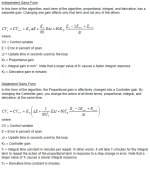Hi all,
I'm trying to fully understand the different effects of the Loop Update Time parameter within the Logix PID instruction.
I was always under the belief that you should code the PID instruction in a periodic task, and set the PID Loop Update Time parameter to match the interval of the periodic task.
The reason I ask is that after upgrading an L32E CPU to an L33ER, and migrating the logic, the PID is now acting MUCH less aggressively than it was before. All setpoints have been transferred over exactly the same - the only difference is the old CPU had the PID in a Continuous task, with a Loop Update time of 2 seconds set. The new CPU is the same, except the PID is now in a periodic task set to 2 seconds (and a Loop Update of 2 seconds also).
My interpretation must be wrong, as either the old PID was executing much quicker than every 2 seconds, or the new one is executing much slower than every 2 seconds? What actually is the best practice? How do I ensure a migration that retains the exact same operation without fail? Why is the advice to use a periodic task AND the Loop Update Time, why not one or the other?
Thanks.
I'm trying to fully understand the different effects of the Loop Update Time parameter within the Logix PID instruction.
I was always under the belief that you should code the PID instruction in a periodic task, and set the PID Loop Update Time parameter to match the interval of the periodic task.
The reason I ask is that after upgrading an L32E CPU to an L33ER, and migrating the logic, the PID is now acting MUCH less aggressively than it was before. All setpoints have been transferred over exactly the same - the only difference is the old CPU had the PID in a Continuous task, with a Loop Update time of 2 seconds set. The new CPU is the same, except the PID is now in a periodic task set to 2 seconds (and a Loop Update of 2 seconds also).
My interpretation must be wrong, as either the old PID was executing much quicker than every 2 seconds, or the new one is executing much slower than every 2 seconds? What actually is the best practice? How do I ensure a migration that retains the exact same operation without fail? Why is the advice to use a periodic task AND the Loop Update Time, why not one or the other?
Thanks.




